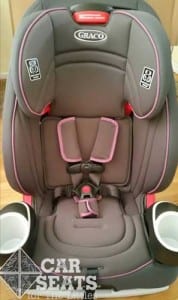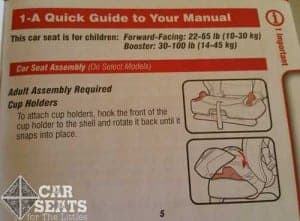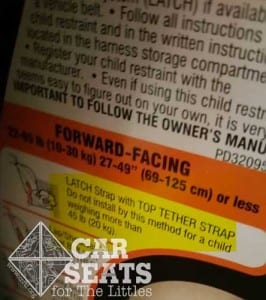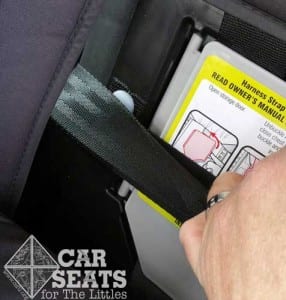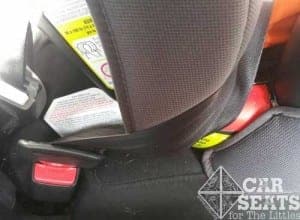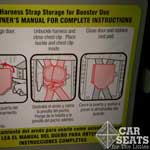This is a very exciting time for Graco combination seats! The lineup now features a no-rethread harness on the Nautilus and two new seats that have a lot to offer, the narrow Tranzitions and the well-priced Atlas 65. Boasting a tall 18.5″ top harness height, this long-lasting $129 option is an exciting addition to the marketplace. Let’s take a closer look at this lightweight harness to booster seat.
CSFTL Quick Stats
- Forward facing weight range: 22-65 lbs
- Forward facing height range: 27-49″
- High back booster weight range: 30-100 lbs
- High back booster height range: 38-57″
- Highest harness position: 18.5″
- Highest booster belt guide position: 20″
- Expiration: 7 years
- Lower anchor weight limit: 45 lbs
- Two position recline
- Two position crotch strap (4.5″ and 6.5″ from the back of the seat)
Measurements
- Width: 19″ at the widest point (cupholder to cupholder)
- Seat pan: 11.5″ back to front, 12″ across
- Height: 32″ with headrest fully extended, 25″ with headrest all the way down
Assembling the Seat
The Atlas arrives without the cupholders installed. To install them, align the front of the cupholder with the seat’s shell, then rotate the cupholder back until it locks into place.
Once assembled, the cupholders are required to remain attached to the seat.
Installation
Seat Belt Installation
The Atlas can be installed with the lower anchors (children 45 lbs or less) or with the seat belt (children of any weight in the seat’s allowable weight range). Always use the top tether in addition to either installation method.
The seat’s labeling mentions using the top tether and clearly lists the weight limit. This kind of clear labeling always pleases us.
My primary model weighs 49 lbs so I installed the Atlas using the seat belt and top tether. The Atlas has a very similar shell to the Graco Nautilus so I used the same technique I use to install a Nautilus in my 2009 Mazda 5 — reclining the seat back a click or two, installing the seat, then moving the seat back upright. That method worked just as well with the Atlas but isn’t necessary in most vehicles.
Lower Anchors Installation
The Atlas can be installed with lower anchors for a child who weighs 45 lbs or less. Installing the Atlas using lower anchors was quite simple. Snapping down the cover revealed the entire belt path! I was able to attach the lower anchors, then reach in and pull the lower anchor’s tail straight across while pushing the Atlas back toward my vehicle’s seat back. This method resulted in a fast, secure installation.
Fit to Child
Harnessed Mode
Our model is 5 years, 10 months old. She weighs 49 lbs and is 47 inches tall. The Atlas has a very similar fit to her Nautilus 65 with Safety Surround so she found the Atlas a good fit from the start!
This model is quite particular about how things feel behind her — she prefers a seat with a smooth cover and a belt path that keeps the seat belt or lower anchor strap from touching her back. I’m pleased to say that the Atlas fits the bill in both areas.
The harness needs to be at or above her shoulders, the headrest does not need to be in any specific position in relation to the child’s head while in harnessed mode.
She’s unable to unbuckle this crotch buckle style herself but she’s able to release the chest clip. A Buckle Bopper might help older children unbuckle themselves from this seat.
Switching Between Harness and Booster Mode
Converting the Atlas from harness mode to booster mode is similar to converting the Graco Milestone to booster mode. The instructions currently say to remove the harness covers, but the storage compartment label indicates that they should be stored there. Graco has confirmed that they’re fine to store in the compartment. We hope to see a manual update that reflects this.
To convert the Atlas to booster mode, loosen the harness all the way. Unbuckle the buckle tongues from the crotch buckle, clip the pieces of the chest clip together, then raise the headrest all the way up. Lift the cover flap below the headrest, then unsnap the cover to access the harness storage. Finally, tuck the harness and buckle tongues inside the compartment.
The manual also lives in this handy compartment so you can access the instructions when the seat is installed.
The manual doesn’t specify where to store the crotch buckle. We hope to see a manual update that reflects this as well.
Pro tip
When installing the Atlas, make sure that the harness is in front of the seat belt or lower anchor webbing when installing the seat. Otherwise, you’ll wind up with a trapped harness and have to start your installation over again.
Not that this happened to me. And if it did, I certainly wouldn’t take pictures to prevent it from happening to you.
Booster Mode
Fit to Child: 5 Years Old
5 years, 10 months old, 49 lbs, 47 inches tall
Here we see our model from earlier. She’s still 5 years, 10 months old, weighs 49 lbs and is 48 inches tall. Though her height and weight exceed the minimum requirements for booster mode on this seat, she prefers a harnessed seat most of the time so I was anxious to see what she thought about booster mode.
She had a bit of a hard time buckling the seat belt because the lap belt path is on the low side so the seat belt tends to bunch up a bit. Eventually we were able to get the lap portion of the belt to lay flat. This may be caused by my car’s rigid buckle stalks so we’ll try booster mode in some other cars.
The belt fit is great, the lap portion lies just over her thighs and the shoulder portion lies over the middle of her shoulder. When the headrest is below the shell of the seat, the seat belt tends to catch in the belt guide a bit. We see this on a lot of combination and multimode seats so it wasn’t unexpected. With the headrest raised above the shell of the seat, the belt moved more smoothly through the belt guide.
Fit While Sleeping
The child who never sleeps in the car was kind enough to demonstrate what sleeping in the Atlas looks like. I’m pleased to tell you that her head remained upright during what ended up being a rather long nap. Head slump while sleeping isn’t a safety concern.
Fit to Child: 9 Years Old
At 9 years old, 60 lbs and 50 inches tall, this model is at the top of the height range for this seat in booster mode. She had the same trouble buckling the seat that our other model did — though she could reach the buckle without issue, she had a hard time getting the belt to lay flat.
She finds the Atlas quite comfortable and the belt fit is good. This wouldn’t be a long lasting booster option for her but she’s enjoying riding in it for the moment.
Special Concerns
Missing Age Limit
The minimum weight for this seat is 22 pounds. That’s two pounds more than previous Graco combination (forward facing only seats that convert to a booster) seats used to have.
Since we’re huge proponents of children riding rear facing until at least age two, this change should mean that caregivers use these seats a little later. In theory that means children will ride rear facing for some time before moving to a seat like the Atlas.
HOWEVER. This seat, the similar Tranzitions, and more-featured Nautilus no longer list a minimum age (though some versions of the Nautilus still list a 1 year minimum age). The seats only list a 22 pound minimum weight limit. While we applaud any effort that delays a move from a rear facing seat to a forward facing seat, we’ve already noticed that some caregivers see the weight-only limit and decide to use the seat for their 22+ pound infant.
We hope that updated versions of this seat have a 2 year minimum age for use.
Booster Age Minimum
The minimum age for booster mode use on this version of the seat is 3 years old. At no point do we advocate for a child younger than 5 years old riding in a booster. The manual does suggest that caregivers follow the AAP and NHTSA guidelines and use the Atlas in harnessed mode for as long as the child fits. This warning is on the bottom of the opposite page from the seat’s age/weight ranges. We’d love to see this warning moved to just below those age/weight ranges.
Graco reports that the minimum age for booster use is being raised to “at least 4 years old” for all combination and booster seats, including newer versions of the Atlas. We look forward to seeing that on all of their seats!
Travel
I haven’t had a chance to travel with the Atlas yet but I can say with some confidence that it would be a great option for airplane travel. It’s lightweight and not terribly bulky so getting it around the airport wouldn’t be too difficult. The only issue it might have is the open belt path — it’s possible that an airplane seat belt’s buckle might wind up right behind the child’s back. Some children find that uncomfortable.
Side Overhang
When this car seat is installed on the plus one or jump seat of a minivan, Graco has confirmed up to 20% of the base can overhang the edge of the vehicle seat while in harness mode. In booster mode the entire base must be in contact with the vehicle seat.
Important Information: Where to Find
FAA Approval
In harnessed mode, the Atlas is approved for airplane use. The sticker is located on the lower left side of the seat’s shell.
This seat is NOT approved for airplane use in booster mode. Boosters require a shoulder belt, and airplanes don’t have shoulder belts. However, in harnessed mode this seat can and should be used on board if it is your child’s harnessed seat.
Expiration Date
The DOM sticker is found on the left side of the seat’s shell, toward the top of the seat. The seat’s expiration is 7 years.
Manual Storage
The manual stores in the same handy cubby where the harness is stored when the seat is in booster mode. This is especially convenient because the manual is accessible when the seat is installed.
Pros
- Inexpensive
- Easy to install
- Lightweight
- Easy to convert between harness and booster mode
- can use LATCH in booster mode
Cons
- Does not convert to a backless booster
Overall Thoughts
The Atlas is a welcome addition to the world of combination seats. As more families choose to keep their Littles harnessed (then in boosters) longer, affordable, lightweight options like the Atlas add an excellent option to their choices.
Graco supplied the Atlas Harness to Booster car seat used in this review but as always, our opinions are our own.
Our friends at Graco are giving a lucky winner an Atlas of their very own. Enter below for your chance to win! Can’t wait until the winner is announced? Check out the Graco Atlas on Amazon!

